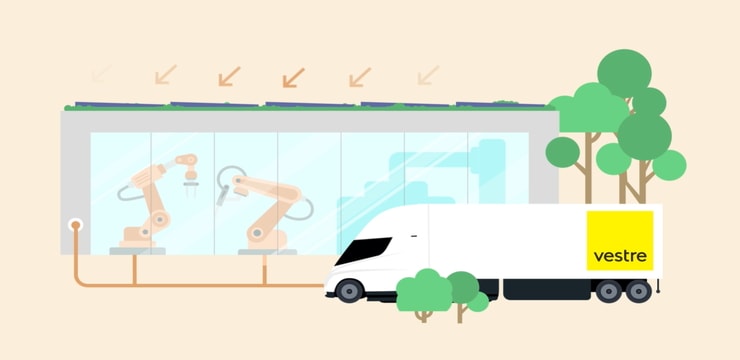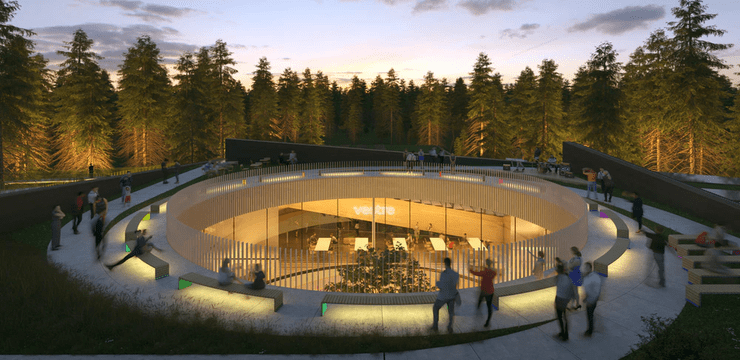Norwegian Design Displays the Future of Solar Powered Factories
Page Contents
Written by qualified solar engineer Aniket. Last updated:
The word ‘factory’ often evokes images of large, dull buildings. A Norwegian furniture factory is about to shatter that image with their new factory design. The design involves abundant greenery surrounding the building, but more importantly – a sustainable design that employs 1,200 solar panels churning out 250,000 kWh to power the operations.
The company, named ‘Vestre’ has planned to create a hypermodern and sustainable manufacturing facility located in 74 acres of greenery. The building, titled ‘The Plus,’ will be designed by Danish architectural firm Bjarke Ingels Group (BIG) and is touted to achieve BREEAM Outstanding – the highest environmental certification of the Nordic region. The new factory will help Vestre cut their carbon emissions by a laudable 50%.
The Role of Solar

Planned design of ‘The Plus’ (source – Vestre)
The planned design of the new factory involves installing 1,200 solar PV panels on the roof. Installed at the optimum orientation, these panels will generate a total of 250,000 kWh of emission-free energy every year.
Coupled with heat exchangers and geothermal wells, this will reduce the building’s greenhouse gas emissions by at least 50% as compared to conventional factories of similar size. Besides this, the building will also recycle and reuse 90-95% of the water used in production.
The factory will also use electric trucks from Tesla for logistics requirements. Combined, the solar panels and other energy efficiency measures make the building’s energy requirements 90% lower than conventional buildings of a similar size.

Diagram Showing Solar Panels Powering Production and Electric Trucks (source – Vestre)
The Plus’s design has thus managed to achieve a rating of A in energy efficiency (G being the lowest and A being the highest).
For this reason, Vestre mentions the upcoming factory building as ‘Paris-proof’, meaning it will meet all the requirements set out in the Paris Agreement’s climate accord.
Norway’s Renewable Landscape
Norway has been leading the renewable energy charge for quite a while now. It is Europe’s largest hydropower nation and has over 90% of its energy come from hydro energy. Despite that, the nation has made significant progress in solar energy.
Being located closer to the Northern pole than most countries on the planet, Norway has limited solar resources. However, it is one of the notable manufacturers of solar power equipment, from cell wafers to solar panels.
More Than Just a Green Building

The Plus’s Rooftop Section (source – Vestre)
Vestre’s plan to build what they term ‘the world’s most environmentally friendly factory’ comes with a fivefold objective.
Along with aiming to build a sustainable building, it also aims to create a space that attracts tourists from all over the world in their 74-acre public park and visitor center. This 30-hectare park will be filled with elements of Nordic culture as well as adventure. Imagine camping in thoughtfully designed natural space – you can even use solar camping gear for a complete emission-free camping experience.
The factory campus will not only allow visitors to enjoy the green campus surrounding the facility, but also experience the factory itself. Covered with transparent glass panels from all sides, visitors can roam around the facility and are able to view the production procedures. Visitors can also visit the rooftop space, which is said to be another unique experience in itself.
The new design also aims to inspire more people to engage in the ‘green shift’ by catering for school visits to the sustainable facility.
The new facility will create between 30 and 70 new jobs and according to the company, will be a model for inclusive workplaces.
The building is designed by Bjarke Ingels Group (BIG), who has also designed the Google Headquarters, and has respectable experience in designing energy efficient buildings.
References
- Bjarke Ingels Group – BIG
- Energy and Cleantech in Norway – Innovasjonnorge
We hope you liked this article. Please rate it or leave us a comment.
Average rating 5 / 5. Vote count: 1
No votes so far! Be the first to rate this post.





